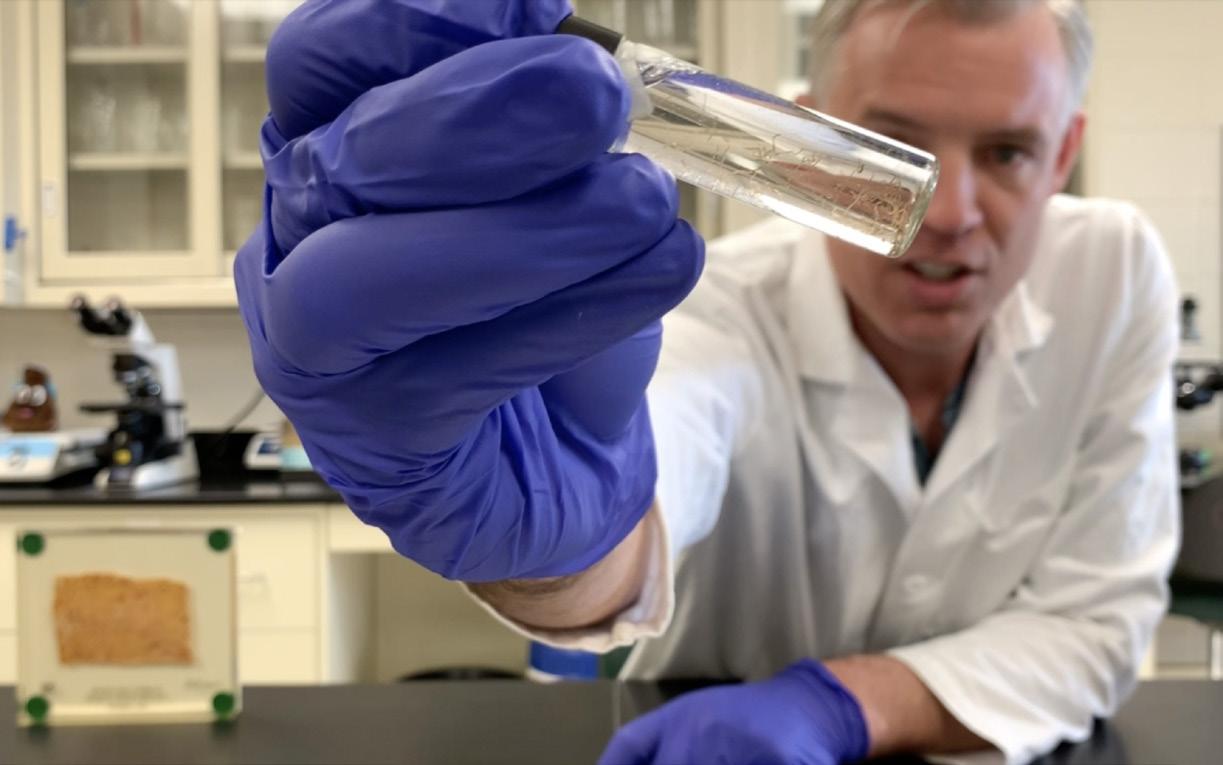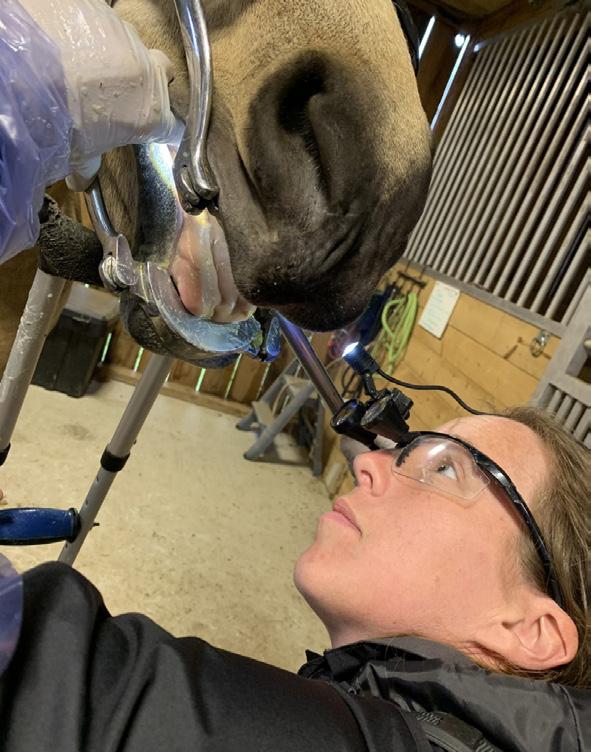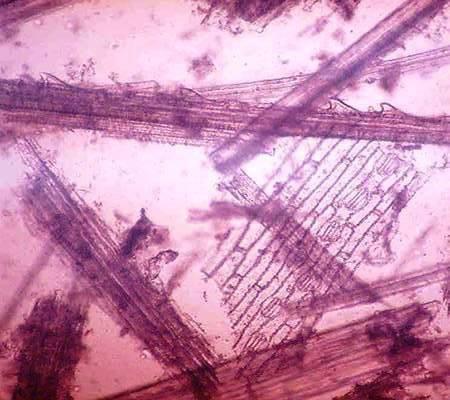
29 minute read
BETTER UNDERSTANDING TOWARD LEADING CAUSE OF EQUINE ABORTION
from Equine Science Review: highlighting research and outreach efforts at the University of Kentucky
RESEARCHING THE NORMAL TO BETTER PREDICT THE ABNORMAL HOW ONE RESEARCHER IS USING HER BACKGROUND IN REPRODUCTIVE IMMUNOLOGY TO BETTER UNDERSTAND THE LEADING CAUSE OF EQUINE ABORTION
The phenomenon of pregnancy has fascinated researchers for centuries. How does the developing fetus, a foreign body that expresses antigens from the father, survive undetected by the mother’s immune system? Initially, pregnancy was believed to survive due to a suppressed maternal immune system; and yet pregnant women can battle infection and mount responses to vaccines and any number of pathogens, leading to the realization that the female immune system wasn’t suppressed, but rather altered. But, what about the horse? This topic has been the primary focus of recent research by Carleigh Fedorka, PhD, postdoctoral scholar in the Gluck Equine Research Center laboratory of Barry Ball, DVM, PhD, Dipl. ACT, Albert G Clay Endowed
Advertisement
Chair in Equine Reproduction. While much can be inferred from the human, the pregnant mare differs physiologically from the
pregnant woman in a variety of ways. Human gestation relies solely on the endocrine support of progesterone, while equine gestation is supported by metabolites of this hormone during much of gestation. The human fetus is surrounded by a single fetal fluid compartment (the amnion), while the equine fetus resides within two (the amnion and allantois). And while human placentation is a single layered hemochorial type (‘invasive’), equine placentation is a multi-layered epitheliochorial placenta (‘non-invasive’). Taken together, inferences made between the two may not be relevant. Therefore, Fedorka’s research has focused on an understanding of the normal immune response to pregnancy in the horse, in addition to evaluating alteration within this response following pregnancy-related complications, such as in the case of placentitis. To begin, the adaptive immune response to pregnancy was evaluated, the findings of which were recently published in the article, “Alterations in T cell-related transcripts at the feto-maternal interface throughout equine gestation,” in the journal Placenta. This branch of the immune system dictates both response to pathogens (pro-inflammatory Th1 cells / anti-inflammatory Th2 cells) in addition to tolerance of the semi-allogeneic fetus (meaning its genetic make-up is not identical
PHOTO BY UK AGRICULTURAL COMMUNICATIONS to the dam) by the regulatory T cells (Tregs). In the normal equine pregnancy, numerous aspects of the adaptive immune response were found to mimic what has been noted in the human, the most important of which was that the induction of tolerance towards the fetus was associated with a heightened Treg response. Additionally, it was noted that no alterations were seen in the pro-inflammatory Th1 transcripts within the semi-allogeneic placenta, indicating an evolved mechanism to remain undetected and not attacked by the maternal immune system. Understanding the normal immune response to equine gestation is an imperative so that alterations within this normal response could be assessed for potential biomarkers, therapeutics and predictors of equine
pregnancy-related complications, of which placentitis remains the largest. In women, pregnancy loss coincides with an increase in Th17 cells alongside a dysregulation of the Treg response, and this can be improved through use of therapeutics that stimulate this arm of immunity, including Neupogen (recombinant GM-CSF) or intravenous immunoglobulins (IVIG; plasma). Data from the laboratory suggests that ascending placentitis leads to an increase in Th17-related transcripts in the placenta, and this coincides with a decrease in Treg-related transcripts in both the endometrium and chorioallantois. It is unknown if a treatment such as IVIG can increase the number of Treg cells in circulation in the horse, but the group recently performed a preliminary study to assess this and hope to have results soon. As the adaptive immune system and the innate immune system are tightly linked, the group has also investigated the cytokines that couple them. Fedorka and team recently published the article, “The feto-maternal immune response to equine placentitis,” in the American Journal of Reproductive Immunology to describe this. In this study, they found that the maternal response to ascending placentitis differs from that of the fetus, as the mare responded to the disease with a primarily pro-inflammatory response, while the fetus appeared to play a regulatory role within this disease and expressed many anti- and immuno-modulating cytokines. Additionally, an increase in many of these cytokines (IL-1, IL-6, IL-10) could be noted in the fetal fluids, suggesting that ultrasound-guided fetal fluid sampling may be considered in detecting placentitis. Unfortunately, due to the risk of abortion caused by medical examination or treatment), few practitioners will utilize fetal fluid sampling as a diagnostic for disease, and the team’s interests shifted towards less invasive sampling procedures for biomarker detection. Fedorka and her colleagues assessed the effect of ascending placentitis on specific cytokines in blood circulation and found interleukin-6 (IL-6) to be elevated. A signaling molecule that can act as both pro- and anti-inflammatory, we also found that in the disease of placentitis, IL-6 activated a specific receptor and signaling pathway to stimulate anti-inflammatory, anti-apoptotic and pro-survival outcomes. IL-6 FOLLOWING INDUCTION OF PLACENTITIS, TH17-RELATED TRANSCRIPTS INCREASED IN THE PLACENTA, WHILE TREG-RELATED TRANSCRIPTS DECREASED. IN HUMANS, THIS PRECEDES PRETERM LABOR AND ABORTION .
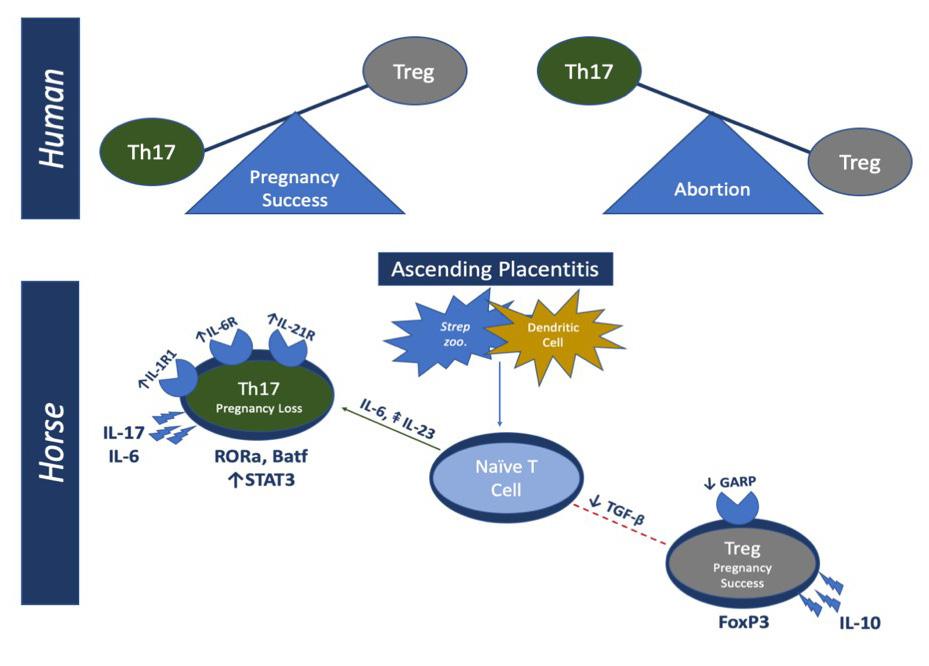
demonstrated both high sensitivity and specificity for detection of placentitis in the experimental model, and future research is needed to see if it is useful in the field. These results will be presented at the American Association of Equine Practitioners annual convention in December 2020. Reproduction is a discipline that involves biomedical issues in several areas, including endocrinology, immunology and infectious disease. It is only with a grasp of the various topics within that researchers can make appropriate inferences into the diseases, disorders and problems that affect the cornerstone of our industry: the broodmare. It is through this conjunction of reproduction and immunology that Fedorka hopes to benefit the industry by improving the understanding of both normal and abnormal. While the normal is fascinating on a scientific level, it is with this information that future research can assess the abnormal, eventually utilizing this information to develop biomarkers for disease prediction, alter management for disease prevention and assess therapeutics for improvement of outcomes. The topic of reproductive immunology paves a path in each of these directions, all of which target the main goal of UK’s reproduction laboratory: overall health of the horse.
| Carleigh Fedorka, PhD, postdoctoral scholar in the Gluck Equine Research Center laboratory of Barry Ball, DVM, PhD, Dipl. ACT, Albert G Clay Endowed Chair in Equine Reproduction, provided this information.
UK EQUINE UNDERGRADS TAKING RESEARCH REINS
University of Kentucky Equine Science and Management undergraduates are able to choose from a variety of internships to complete course credits, including positions in UK equine research. Two of the program’s undergraduates recently highlighted their internship experiences during the major’s Spring 2020 Internship Showcase event. Jenna Bryant, a junior in the program, and Dagan Montgomery, who just graduated with his degree, chose to do their internships in equine-related research. Bryant worked under Jill Stowe, PhD, associate professor in UK’s Department of Agricultural Economics, analyzing Thoroughbred yearling sales in United States markets.
Montgomery worked under Ashley Fowler, PhD, and Mieke Holder, PhD, both researchers in the Department of Animal and Food Sciences, seeking to measure how different supplements in horse feed affected forage plant growth. Both sought to improve an industry they are passionate about. Bryant’s responsibilities were to uncover as much data as she could find in the realm of yearling sales and economic indicators, going as far back as 1936. She then compiled that data into a usable format for analyzing. Bryant recalled spending a lot of time in the Keeneland Library. Through this research, she was published in an academic journal with Stowe on their findings, a study that analyzed profitability of yearling sales based on seven stud fee categories. Her passion from this project came from her experience in the breeding, buying and selling aspects of the industry. “I know all too well how hit or miss this market is, which is why I jumped at the chance to understand the economics of it,” Bryant said. Her advice to other undergraduate students seeking a career in research? “Ask your favorite professors if they have anything going on, or if they’ve heard of any professors in the department looking for help,” she said. “It’s a great way to get some credit hours out of the way, while also giving you a chance to present what you’ve accomplished.” “One of the most rewarding parts of my job is having the opportunity to advise and mentor undergraduate students who are passionate about pursuing research. Initially, I teach them a few tools they might learn as a grad student and then let them get their hands dirty,” Stowe said. “What I typically find is that this introduction sparks a new level of intellectual curiosity, and they start thinking about new research questions and how these tools might be used to answer them. This is very exciting to me! I also enjoy these opportunities because I think they help students appreciate the scientific process and to continue developing their ability to think more critically about problems and solutions.” As she begins her senior year this fall, Bryant plans to continue with Stowe and tackle other interesting projects that have been on the back burner. Montgomery’s research was
Pasture management
Graze cover crops using temporary fencing. As pasture growth begins, rotate through pastures quickly to keep up with the fast growth of spring. As pasture growth exceeds the needs of the livestock, remove some fields from the rotation and allow growth to accumulate for hay. Determine need for supplemental warm season forages. Flash graze pastures newly seeded with clovers to manage competition.
Detailed Ag Weather Forecast
We all know not to cut hay if it’s going to rain tomorrow, but have you ever wondered about the drying conditions: humidity + cloud cover + wind speed + temperature?
The University of Kentucky Ag Weather Service provides this kind of detailed forecasts in three-hour time intervals. Visit http:// weather.uky.edu/ky/forecast. php#Point_Ag_Forecast
Source: University of Kentucky Forage News, April 30, 2020
related to equine nutrition and the results of horse feed supplements on composted manure. His responsibilities involved preparing manure samples from horses fed mineral supplements in specific groups and organizing strategically seeded fescue. He also recorded plant growth and counted germination rates of each study group every two days. When asked about the project, Montgomery said, “It was intended to gain a better understanding of how common equine mineral supplements impact the growth of forages in the field so that horse operations will know whether or not their compost piles will be beneficial to their pastures based on their horse’s diet.” According to him, the most rewarding part was watching his predictions come to fruition. Montgomery graduated May
As a research assistant to Dr. Stowe, I have been able to participate in several projects, from start to finish. Last year, we published a paper titled Estimating the Profitability of Commercial Thoroughbred Breeding in the United States. We studied this issue by analyzing yearling sales in Kentucky and New York, and then developed several models that divided the data by stud fee categories, and discussed theoretical discounts that would be necessary to get to a threshold of 50% or 67% profitable sales. We decided to use this internship to build off that study, this time using all yearling sales in the United States, using data as far back as 1935. To get this project running, it was my responsibility to gather as much data as possible from a variety of sources. I adjusted all of this data for inflation in order to be able to properly analyze across many years, and ran several statistical analyses. This enabled me to develop three models that will predict the average sales price and gross revenue of yearling sales in the United States. We are currently in the process of writing a paper discussing these models and how the average sales price reacts to periods of economic contraction versus expansion. In addition to this project, I also assisted with data curation for a couple other projects regarding the thoroughbred breeding industry.
Description of Responsibilities and Activities
One of the very important results of our current research, showing that average prices respond quickly to downturns in GDP, but are slow to respond to increases.
Professional Growth Goals
Further my leading economic indicators research as it applies to thoroughbred yearlings and find at least five market indicators that are statistically significant to an 84-year data set.
Strategies: Collect data related to US Thoroughbred yearling markets. Develop a list of economic and industry indicators that relate to the thoroughbred breeding and racing industry. Start a new study that analyzes profitability in a different way by the end of
January 2020. This new study will need to be defined and data gathered by the end of February 2020.
Strategies: This will help to address an issue in our last paper, which was that of whether or not breeders paid the entire stud fee.
Publish a second paper by the end of 2020 that continues my yearling profitability paper and addresses some of the continued research from the previous discussion.
Strategies: Looking back at my most recent paper, there were several points that could be further researched. The research will be completed in this internship this semester; I will begin the paper over the summer and use fall semester as an editing period.
Move away from specific year to year data, and instead learn how to process decades worth of data in order to see larger patterns. Learn Stata by the end of February to assist with this goal.
Strategies: Learn modeling techniques that will display the data more comprehensively. Perhaps patterns will have explanations such as the Great Recession, 9/11, the beginning of a war, a new administration taking office, or a major racing scandal. This is the last step in analyzing the patterns.
From working the sales to analyzing them, this industry and its markets have always been fascinating to me.
Working for the university has taught me a lot. Just going through the process of setting up payroll and filling out various forms was very beneficial. Working in the Department of Ag Econ has also been a huge help, as I feel that I have been able to make connections with professors that I haven’t been able to take a class with, and it was a comfortable setting for me as I already knew so many of them. Getting to continue my work with Dr. Stowe has been a dream. We were able to research a model to predict the average price and gross revenue of yearling sales in the United States, using indicators such as GDP lagged by 2 years, the number of yearlings sold the prior year, and the average price from the prior year. We also analyzed things like gold prices, oil prices, disposable income, and annual foal crop size. Overall, we developed a model that is statistically significant in not only predicting price and revenue, but also in providing preliminary evidence that the yearling market reacts faster to decreases in GDP growth rate and slower to increases in GDP growth.
Project Development/Issue Analysis
Results from a previous study generated using skills learned in AEC 312
EQM 101 was essential to my remaining in the equine major. Dr. James was a phenomenal professor who did a great job of keeping the class about all horses, not just the specific industries we have here in Lexington. It gave me time to adjust to the racing aspect of things, having come from a primarily equitation/eventing background.
EQM 351 was also a fantastic class, despite being a difficult one. The knowledge I learned in that class was crucial to my previous job at Ashford Stud, where I was responsible for the daily care of mares and foals. More specifically, thoroughbred mares and foals, who loved to get sick.
AEC 312 was a fascinating class and has been the most useful to my coursework to date. It applied economic and statistical analysis directly to many different equine industries and has really helped shape the direction I’ve taken my program. Not only did I learn great excel skills, I also learned modeling techniques that I use in my internship every day!
Professional Growth Outcomes
One of my big goals was to expand the way I analyze data. I was able to do that by learning a statistical program called Stata, which is something I will be able to carry forth through my career as a unique skill. Learning Stata allowed me to navigate decades worth of data and analyze the statistically significant patterns. Dr. Stowe and I are on track to have another paper published by the end of the year. This has been a goal of mine for several months, as being published allows me to show Masters programs and future employers what I have accomplished and flourishes my resume.
I’ve worked in and seen a lot of the breeding industry, from the breeding shed, to broodmare and foal care to weanling sales preparation!
One of the most pressing issues that thoroughbred racing faces is aftercare. There are too many horses who never make it to the track, who don’t have the right pedigree to go straight to breeding, or who make it to the track and don’t recoup their training fees. If they aren’t fortunate enough to make it to a retraining or adoption program, they are lost and will more than likely end up in one of the surrounding countries for slaughter. Aftercare needs to be supported and increased, but the best way to help it is to stop the problem before it happens. By educating breeders and providing a model that can predict the success of a market, the industry will be able to make better economic decisions and not schedule as many “wild card” breedings just to have an extra yearling to sell. By reducing the supply, the market will equilibrate, and hopefully less thoroughbred will be lost in the future.
Acknowledgements
I owe a huge thank you to Dr. Stowe for so many reasons. None of my research would have been possible without her. I wouldn’t have my current job without her, and I never would have learned as much as I did. The Keeneland Library was also instrumental in my data curation, as well as the Jockey Club and the Blood-Horse Staff. Dr. Emily Plant was also a big help with her advice and expertise. Thank you to MDPI, for publishing our last study and giving us the motivation to move the research further. Finally, thank you to the Department of Agricultural Economics for funding our research and being so supportive of our work!
INTERNSHIP SHOWCASE POSTERS, SUBMITTED BY BRYANT (ABOVE) AND MONTGOMERY (BELOW)
8 and plans to pursue graduate school after taking some time to work in the industry. He said this project has solidified his career goals and made him confident about building a career in nutrition research. “I do not have an undergraduate teaching component to my faculty position, so I really do enjoy having the opportunity to have undergraduates in my lab who really want to take the time to learn. I like to give them a project that they can call their own and take pride in. I wish I had such opportunities back when I was an undergraduate student,” Holder said. “In terms of furthering my research program, these projects may be small, but I find the data very useful. In some cases, it may explore the validity of concepts that I would like to pursue in the future, or provide supportive evidence for something we have been working on from a different perspective.” Savannah Robin, MS, UK Ag Equine Programs internship coordinator, said the opportunities undergraduates have in research are not only important for their personal career trajectory, but also for the industry. “One of the coolest things for me to see when our students participate in undergraduate research is the impact they see themselves having on the industry,” she said.
The Effects of Mineral Supplements in Equine Diet on Composted Manure and Plant Growth Dagan Montgomery
Department of Animal Science University of Kentucky, Lexington, KY
My internship was under Dr. Ashley Fowler and Dr. Mieke Holder, helping prepare for and collect data in a research study investigating the effect of mineral supplements in horse diets on how well forage plants grow in those animals’ composted manure. My responsibilities included the preparation of measured compost samples for each test. This was done by combining the composted manure collected from different animals fed different diets into carefully measured sources, with four samples for each diet, including a control group of just water. I then counted and prepared the fescue seeds to be used and planted them within the samples. These samples were watered and kept at a consistent lighting and temperature. Every three days all germinated grasses were counted for each sample, and roughly every five days the total height of each plant was measured. All data, including exact temperature, amount of water given and plat information was carefully recorded and placed into a spreadsheet.
Description of Responsibilities and Activities Abstract Evaluation of EQM Courses
The compost samples, arranged strategically under lighting and watered, awaiting germination
Professional Growth Goals
• Quickly gain thorough understanding of the project and its requirements within the
first week of the internship
Took notes during the first few days of being acclimated to the laboratory and asked questions regarding the specifics of the practices. Never assume to know how something is done without verifying • By the end of the semester, write a detailed paper outlining the goals and hypothesis of the project After gathering all thoughts and notes on the study, I drafted a version of the paper, complete with abstract, discussion, results and conclusion for review by Dr. Holder • Using data, successfully determine which trial seems to actually have an effect on the growth of the plants by the end of the semester or completion of the study After taking carefully recorded data and observations, I will be able to determine exactly which trials, if any, actually impacted the growth and germination rates of these fescue plants • Further my understanding of nutrient flow by reading sources outside of my own work from other schools and researchers within the first month of the study I researched several similar studies and read the abstracts and conclusions published by several other Universities as well as other journal publications having to do with nutrient flow in equine diets • Be able to successfully explain all data and reasoning to the general public at the end of the project in a concise yet clear manner that helps educate them as to the findings of the project I prepared a project poster that describes the goals and findings as well as reviewed all researched material and data
By spreading composted manure such as was used in the study, farmers could potentially help fertilize their existing forage.

Gain thorough understanding of the project and its requirements
I was able to quickly grasp all of the reasoning behind the aspects if this research with the help of Dr. Holder and Dr. Fowler’s explanation.
Write a detailed paper including abstract and findings
Throughout the last few weeks of the semester I have been working with Dr. Holder to put together a well written publication that details the expectations and outcomes of this project, along with the basis of how data was collected
Successfully determine which trial seems to actually have an effect on the growth of the plants
There was a clear indication that the inorganic and organic supplements greatly increased plant growth as was revealed in the data
Further my understanding of nutrient flow by reading sources outside of my own work
By reading several peer reviewed sources, I was able to better grasp the specific biological factors that effect the flow of nutrients through the horse’s GI tract and out into the environment
Be able to successfully explain all data and reasoning to the general public at the end of the project in a concise yet clear manner
I hope with this poster along with the accompanying paper to have been able to organize results into a coherent work that can be easily understood by anyone with a basic understanding of the scientific method using simple language paired with easy to follow graphs and data The samples and fescue plants within them under the growth lamps in the laboratory after three weeks My research seeks to see how mineral supplements in horse feeding programs affect nutrient leaching from feces. We discussed how this nutrient leaching is a by-product of mineral supplements passing through the horse without being absorbed. Many supplement companies market their products by making them seem necessary for a horse to be healthy, and pandering to people who few horses as pets or children rather than livestock. This leads to many horse receiving far more minerals in their diets than they actually need to be eating. At best this causes a waste of nutrients that cost money and can possibly be pollutants. At worst these can be toxic to the horse and harm the surrounding environments. I hope to analyze how impactful this problem is, particularly in Kentucky, and develop a possible solution. I believe education would be the best way to improve this. This is the leading reason behind my research with Dr. Holder. We were attempting to determine the rate at which mineral supplements seem to effect plant growth. We hope to further this research and potentially prepare publications that can be used as extension education to show farmers how supplements do in fact pass through the horse, as well as the potential effects on plant life in the pasture. I chose this issue as it does apply to my research, and has always been something I was curious about anyway. This study was intended to test whether or not mineral supplementation in horse diet affected the efficacy of composted manure on the growth of forage species. The idea was that if different horses were fed a different consistent mineral supplement in their diet, their manure, once composted as would be done on farm, would differ in how well the plants were promoted to grow based on the different minerals present due to that which passes through the horses GI tract. In other words, what the horses do not absorb of mineral supplements they consume would be passed into the manure. This, once composted and applied to grass seeds as soil, would determine to what degree the different mineral supplements effected growth and germination. This study and its results will hopefully be useful as a tool to help horse farms determine what forms of mineral supplements are most likely to pass into the soil, as well as how much these leached minerals will improve or impair grass to proliferate. I was able to prepare and carry out this experiment with the help of Dr. Holder and Dr. Fowler in the Department of Animals Science nutrition lab, including the preparation of samples, the planting and the monitoring and upkeep of plant growth. Several courses at UK were very helpful to my overall understanding of the topic I was assisting to study: • ASC 378-Animal Nutrition- This course helped my understanding of basic nutritional needs, as well as potential hazards with over feeding such as mineral toxicity • ASC 389- Equine Nutrition- Dr. Lawrence’s course informed me of equine specific nutritional factors, including how mineral toxicity can effect horses • CHE 230-Organic Chemistry- This course helped me understand basic chemistry concepts • ASC 325-Animal Physiology- Dr. Urschel’s course assisted with a basic understanding of the digestive anatomy of herbivores and how excess minerals in a diet can be passed through the GI tract
Issue Analysis Professional Growth Outcomes Acknowledgements How height was determined and differentiated between the plants within the different samples.
Dr. Mieke Holder- My internship supervisor and mentor who was gracious enough to give me a position in her lab and helped me understand any material pertinent to the study, as well as helped me with my personal career goals Dr. Ashley Fowler - Dr. Holder’s post-doctoral researcher who allowed me to be part of her own research and helped me throughout the process by explaining all goals and procedures to me
“It’s often the first chance they’ve had to identify and try to solve a problem within this industry and that is so empowering. “Offering undergraduates the chance to take part in research and share the results can open doors in their professional lives they never imagined possible,” she said. The opportunities undergraduates have to participate in equine research has the potential to make a vital difference on their future career goals and on the industry. Students are able to develop critical thinking and analyzation skills they can utilize in any career they choose. UK is home to many of the leading equine researchers, and the university’s undergraduates are given a unique chance to tap into that expertise.
| Lindsay O’Hara, a rising senior double majoring in Equine Science and Management and Communications, is the communications and student relations intern for UK Ag Equine Programs.
JOCKEY & EQUESTRIAN INITIATIVE EXPANDS TO EQUESTRIAN ATHLETE (EqA) INITIATIVE UK RESEARCHERS ADDRESS EQUESTRIAN ATHLETE HEALTH AND WELLNESS AMID COVID19 REENTRY
The Sports Medicine Research Institute (SMRI) housed in the University of Kentucky College of Health Sciences has one of its four main initiatives focusing on the health and wellness of equestrian athletes. Core to the SMRI’s mission is a multidisciplinary approach to research, strong community collaborations and providing direct service to the Commonwealth.
In response to a community engaged research process, the initiative formerly known as the Jockey & Equestrian Initiative, has recently expanded to the Equestrian Athlete (EqA) Initiative. Under this expansion, jockey health remains a priority, but defining “equestrian athlete” is more encompassing than some might first think.
What is an equestrian athlete?
Many individuals work broadly in the equine industry as riders, workers and/or recreational enthusiasts. Equestrian athletes are individuals who interact with horses as their teammate, as their friend or as their client. This means the initiative is not only interested in those riding or driving horses at any level and in any discipline, but is also focusing on those taking care of both the horses and the riders. Horses are often partners in ensuring human health, such as in equine-assisted learning, therapeutic riding and occupational therapy activities.
“With this expansion, we can serve the equestrian community
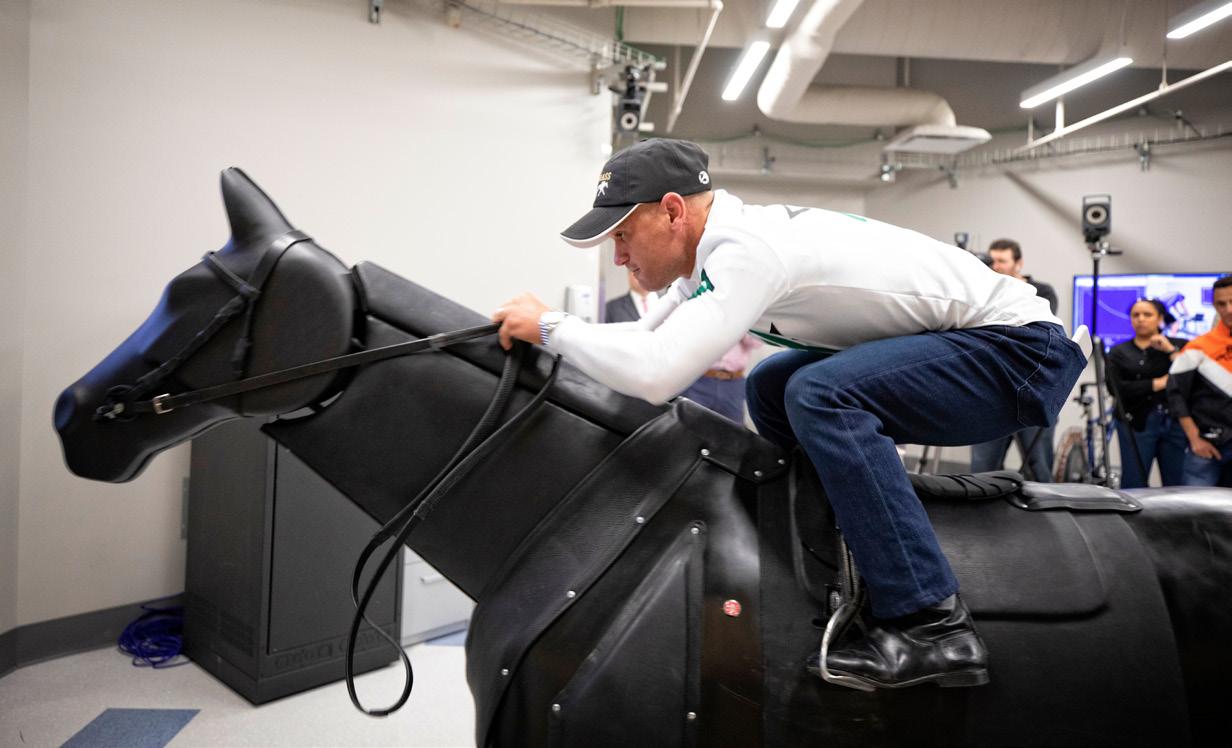
“CHARLIE HORSE,” WITH A JOCKEY ABOARD SIMULATES RACING. PHOTO COURTESY UK PR. in Kentucky and throughout the country,” said Kimberly Tumlin, PhD, MS, MPH, EqA director and assistant professor in UK’s College of Public Health.
The mission of the EqA is to optimize the health, wellness and performance for the equestrian athlete through research. This research will support evidencebased outreach that is specific to equestrian populations.
It is still not clear what physical, social or psychological factors may impact health and wellness of equestrians, particularly at the community level. We consider equestrians in professional and recreational groups, and need to better define the risks and benefits of engaging with horses on human wellness.
Consider that professional equestrians represent a large population of workers with nonstandard work arrangements. These individuals are occupationally classified as non-standard workers with contingent, independent contractor, and/or workers assigned to non-traditional 8 a.m. - 5 p.m. workdays. For example, professional jockeys, competitive eventing riders or horse trainers have unique work demands based within equestrian athletics. With unpredictable work schedules, occupational equestrian athletes’ work is often temporary, with instability due to factors beyond the workers’ control, and often these riders have a lack of legal protections and worker benefits. These riding athletes travel on a regular basis and have additional stress of being under high pressure of competition, which defines ability to secure future work. Lifestyle characteristics could be detrimental to worker health for various demographic groups. Non-riders also have non-standard work arrangements, particularly in the breeding industry that is
so important to the Kentucky economy.
In defining these different roles that equestrians play in the industry, Tumlin and research coordinator Michaela Keener, MS, research administrative coordinator, Equestrian Athlete Initiative, picked up the reins to define EqA’s direction under the support of the SMRI.
“We are truly excited to be able to bring this level of research to the equestrian community with the vision to improve the health and safety of equestrian athletes,” said Nick Heebner, PhD, ATC, director of research, SMRI. Laboratory focusing on health and wellness of jockeys
With the expansion of the initiative to encompass all equestrian athletes, the lab is still working with Keeneland, the Jockey’s Guild and the local Thoroughbred community to continue to focus on the health and wellness of jockeys, exercise riders and novice riders who aspire to be jockeys or exercise riders.
A main feature in the laboratory is the MK Racewood Race Horse Simulator; nicknamed Charlie Horse. Charlie Horse has a remote control mode, as well as a reactive, rider-controlled mode. This allows race riders and other galloping disciplines to ride a horse anywhere from speeds simulated to be 25-40 mph.
“This specific racing simulator is the first in the country to our knowledge, and allows us to capture differences in positions between speeds,” Keener said. “Using our motion capture system, we can determine if a rider is favoring certain joints they may have previously injured while riding and haven’t fully recovered from.”
Elite jockey Sophie Doyle, who participated in performance testing at the lab, believes Charlie Horse and the lab have something new to offer to the community.
“Whether it is establishing a baseline of performance to understand where you are today, or if you are recovering from an injury and want to be able to test how you are recovering, the data they collect will provide insight which we have never had riding in America,” Doyle said.
Like much of the country, human subjects’ research in the SMRI is delayed while we practice social distancing. With both Keeneland’s Spring Meet and the Land Rover Three Day Event among some of the top spring highlights in the Lexington community canceled, and countless shows, clinics and camps canceled or postponed, the EqA team has turned to community members to discuss COVID19’s impact on the equestrian community. The community feedback was most concerned with social, behavioral and economic impacts of COVID19 on their equestrian participation. | Kimberly I. Tumlin, PhD, MS, MPH, director of the Equestrian Athlete Initiative and assistant professor within the UK College of Public Health, in conjunction with Michaela Keener, MS, research coordinator within the UK SMRI, College of Health Sciences, provided this information. “CHARLIE HORSE.” PHOTO COURTESY MICHAELA KEENER.
EQUINE INNOVATORS: COVID-19 AND THE EQUINE ECONOMY WITH DR. JILL STOWE
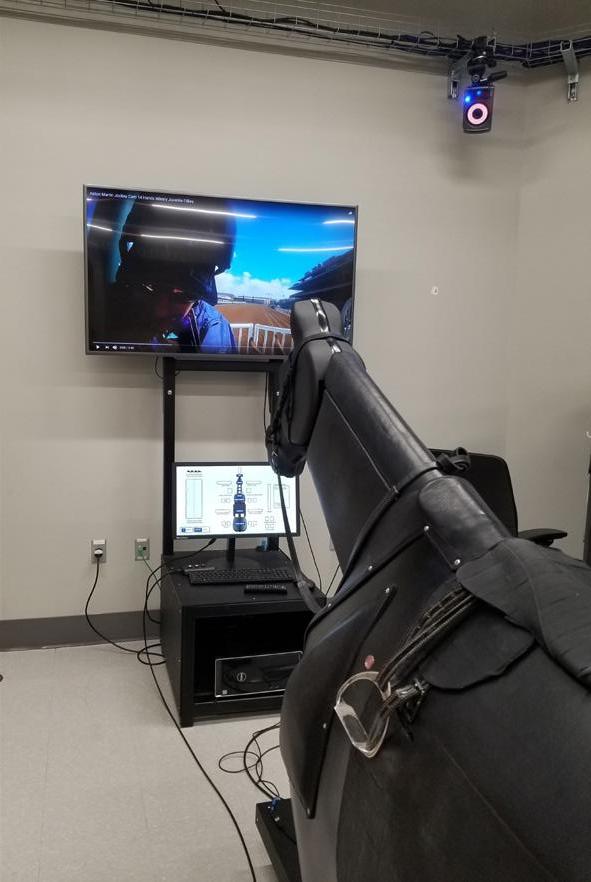
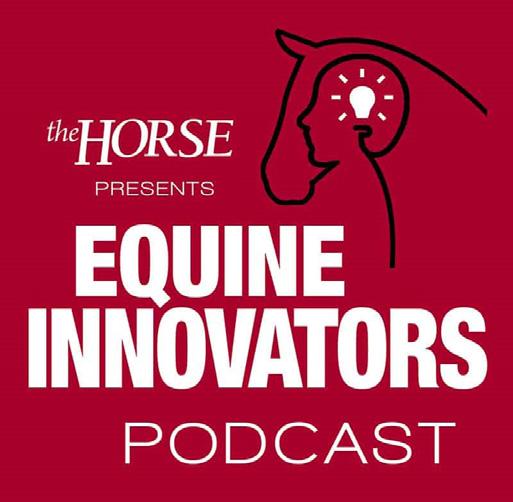
University of Kentucky researcher and equine industry economist Jill Stowe, PhD, associate professor in the UK College of Agriculture, Food and Environment Department of Agricultural Economics, gives a glimpse of how COVID-19 is impacting the horse world and looks at the financial challenges that lie ahead. This podcast is the second episode in our new “Equine Innovators” podcast series, a collaboration between UK Ag Equine Programs and TheHorse.com, brought to you by Zoetis. You can find the Equine Innovators” podcast on TheHorse.com, Apple Podcasts, Spotify, Stitcher, and Google Podcast. Download the podcast at https://thehorse.com/wpcontent/uploads/2020/04/EquineInnovators_Episode2.mp3.
Years of hard work culminating in a successful PhD defense is a rite of passage for graduate students across the country. Conducting your defense live online to a worldwide audience is a novel approach, and one necessitated by the COVID-19 pandemic.
Ashley Steuer, DVM, Zoetis Resident in Veterinary Parasitology and now newly minted PhD from the University of Kentucky Gluck Equine Research Center, found herself in this unique position as she defended her doctorate April 14 to a worldwide audience simultaneously via the Zoom and Facebook Live platforms.
Her dissertation, titled, “HostParasite Interaction in Horses - Mucosal Responses to Naturally Acquired Cyathostomin Infections and Anthelmintic Treatment,” was viewed live by 150 people who were fairly evenly split between the two platforms and hailed from countries including Germany, Switzerland, Italy, the United Kingdom, Denmark, Finland, Sweden, Netherlands, New Zealand, Australia, Abu Dhabi, South Africa, Colombia, Argentina, Brazil and Canada. The audience included several leading parasitologists from around the world. The recorded dissertation, which is available on the Gluck Center’s Facebook Page page (https://www.facebook.com/watch/ live/?v=566563937578152&ref= watch_permalink), has since been viewed more than 1,400 times.
“It was a great experience! It uniquely allowed colleagues, friends and others from around the world to tune into the event that they would not have been able to attend in person. This level of support is a very humbling and heartening experience to witness,” Steuer said. “I hope that others also enjoyed the event and were able to learn from it. That is why we are here, to promote and spread quality research concerning the horse. Of course, it is a little nervewracking to undergo any defense event, but it wasn’t so intimidating, as, at times, it felt like I was speaking to myself.”
“I particularly enjoyed Ashley’s interaction with her audience”, said her research mentor, Martin Nielsen, DVM, PhD, Dipl. ACVM, Schlaikjer professor of Equine Infectious Disease, associate professor at the Gluck Center. “Several questions were asked during the event. On Zoom, participants used the chat function for asking questions, and Ashley responded to those within the session. Several additional questions were asked on Facebook, where about 50 comments were made, and Ashley responded to all questions posted there after her defense.
“I like how our graduating students can get an opportunity like this to demonstrate their acquired skills as science communicators, and I would like to see us using Facebook live for PhD defense seminars again in the future,” he said.

About Steuer
Steuer earned her Bachelor of Science from Michigan State University in 2012 and her Doctor of Veterinary Medicine from the University of Tennessee in 2016. While in veterinary school, she discovered that her passion was veterinary parasitology.
According to her bio, Steuer followed this passion by pursuing a dual PhD/residency program through the National Center for Veterinary Parasitology, where she became the Zoetis Resident for Veterinary Parasitology at the Gluck Center. Over the last four years, she has participated in many research projects, including the evaluation of the immunologic
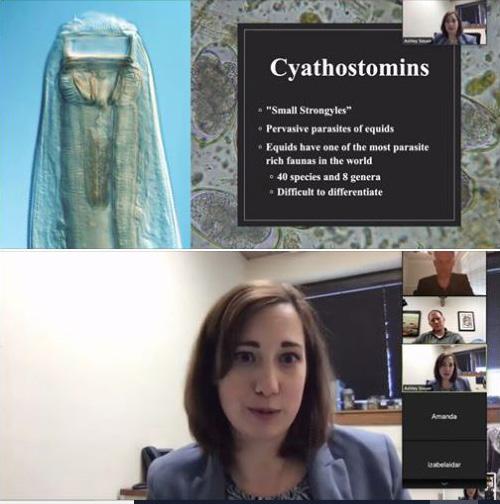
and inflammatory reactions to anthelmintic treatment in horses; identification of a novel species of parasites in wildlife; testing novel anthelmintic treatments in horses; validation of an automated fecal egg counting method prototypes; a combination deworming study; a parasite prevalence and management practice assessment of rural Kentucky farms; evaluation of common diagnostic techniques; and the development of an in vitro protocol and for maintaining and transcriptome analysis of adult Parascaris spp.
Steuer has published two first author manuscripts and served as co-author on seven published manuscripts. She has also participated in numerous extension events, such as speaking about parasite control to local equine clubs and assisting with developing parasite control programs for local farms.
She has been actively involved in teaching through Lincoln Memorial University College of Veterinary Medicine and the University of Tennessee College of Veterinary Medicine. She also pursued her passion of diagnostic parasitology through the UK Veterinary Diagnostic Laboratory and the UTCVM Veterinary Parasitology Diagnostic Laboratory.
About her dissertation research
According to Steuer’s published abstract, Cyathostomins are ubiquitous parasites in horses. In rare cases, cyathostomins lead to a generalized typhlocolitis (inflammation of the caecum and colon) and death. In healthy horses, local reactions are noted to the mucosal larvae; however, the mechanisms and

importance of these reactions has not been explained. It has been hypothesized that anthelmintics can alter these reactions.
Two studies were conducted to clarify the local and systemic immune response following larvicidal treatment. In the first study, ponies with naturally acquired cyathostomin infections were allocated into three groups: fenbendazole-treated (FBZ), moxidectin-treated (MOX) and untreated control.
The second study aimed at evaluating a larvicidal treatment and a non-larvicidal treatment belonging to the same anthelmintic class to classify the local and systemic immune response following larvicidal treatment. Horses with naturally acquired cyathostomin infections were allocated into three groups: Ivermectin (IVM)/praziquanteltreated, MOX/praziquantel-treated and untreated control.
Overall, these studies demonstrated that treatment with an anthelmintic, both larvicidal and non-larvicidal, in healthy horses does not significantly change the proinflammatory or ant-inflammatory response. In fact, it may decrease the local mucosal response in horses, due to the decrease in worm burdens. Cyathostomins induce a proinflammatory response within the host tissue, while the encysted larvae may also induce an antiinflammatory response as well.
| Holly Wiemers, MA, APR is communications and managing director of UK Ag Equine Programs.

